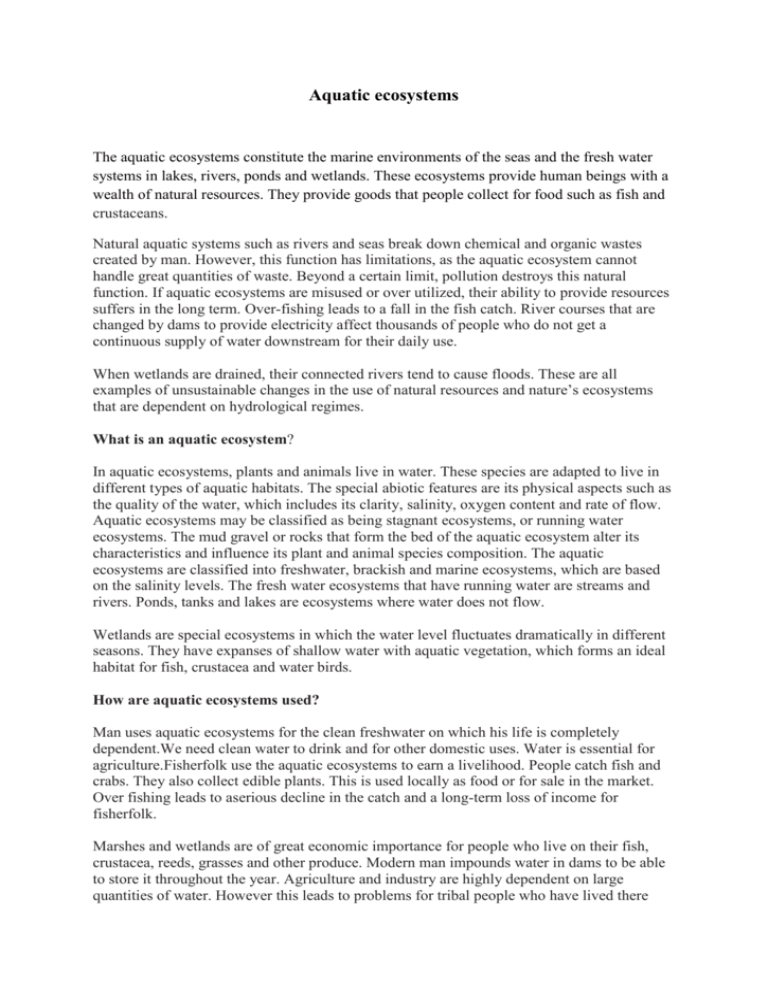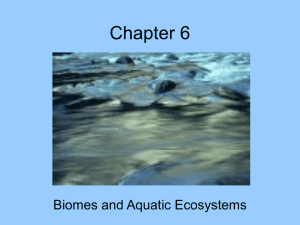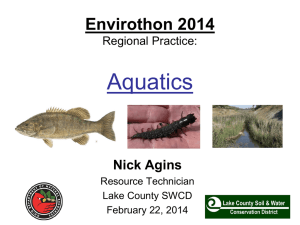Aquatic ecosystems
advertisement

Aquatic ecosystems The aquatic ecosystems constitute the marine environments of the seas and the fresh water systems in lakes, rivers, ponds and wetlands. These ecosystems provide human beings with a wealth of natural resources. They provide goods that people collect for food such as fish and crustaceans. Natural aquatic systems such as rivers and seas break down chemical and organic wastes created by man. However, this function has limitations, as the aquatic ecosystem cannot handle great quantities of waste. Beyond a certain limit, pollution destroys this natural function. If aquatic ecosystems are misused or over utilized, their ability to provide resources suffers in the long term. Over-fishing leads to a fall in the fish catch. River courses that are changed by dams to provide electricity affect thousands of people who do not get a continuous supply of water downstream for their daily use. When wetlands are drained, their connected rivers tend to cause floods. These are all examples of unsustainable changes in the use of natural resources and nature’s ecosystems that are dependent on hydrological regimes. What is an aquatic ecosystem? In aquatic ecosystems, plants and animals live in water. These species are adapted to live in different types of aquatic habitats. The special abiotic features are its physical aspects such as the quality of the water, which includes its clarity, salinity, oxygen content and rate of flow. Aquatic ecosystems may be classified as being stagnant ecosystems, or running water ecosystems. The mud gravel or rocks that form the bed of the aquatic ecosystem alter its characteristics and influence its plant and animal species composition. The aquatic ecosystems are classified into freshwater, brackish and marine ecosystems, which are based on the salinity levels. The fresh water ecosystems that have running water are streams and rivers. Ponds, tanks and lakes are ecosystems where water does not flow. Wetlands are special ecosystems in which the water level fluctuates dramatically in different seasons. They have expanses of shallow water with aquatic vegetation, which forms an ideal habitat for fish, crustacea and water birds. How are aquatic ecosystems used? Man uses aquatic ecosystems for the clean freshwater on which his life is completely dependent.We need clean water to drink and for other domestic uses. Water is essential for agriculture.Fisherfolk use the aquatic ecosystems to earn a livelihood. People catch fish and crabs. They also collect edible plants. This is used locally as food or for sale in the market. Over fishing leads to aserious decline in the catch and a long-term loss of income for fisherfolk. Marshes and wetlands are of great economic importance for people who live on their fish, crustacea, reeds, grasses and other produce. Modern man impounds water in dams to be able to store it throughout the year. Agriculture and industry are highly dependent on large quantities of water. However this leads to problems for tribal people who have lived there before the dams were built as they are displaced to build large dams. These dams make rich people richer in the farmland and supports people in large urban centres that use enormous quantities of water. The poor tribal folk become even poorer as the natural resources they depend on are taken away as their lands are submerged under the water of the dam. Dams are built across rivers to generate electricity. A large proportion of this energy is used by urban people, by agriculturists in irrigated farmlands and in enormous quantities for industry. Large dams have serious ill effects on natural river ecosystems. While water from dams used for irrigation has lead to economic prosperity in some areas, in semiarid areas that are artificially irrigated the high level of evaporation leads to severe salinisation as salts are brought up into the surface layers of the soil. This makes such lands gradually more and more saline and unproductive. What are the threats to aquatic ecosystems? Water pollution occurs from sewage and poorly managed solid waste in urban areas when it enters the aquatic ecosystem of lakes and rivers. Sewage leads to a process called eutrophication, which destroys life in the water as the oxygen content is severely reduced. Fish and crustacea cannot breathe and are killed. A foul odour is produced. Gradually the natural flora and fauna of the aquatic ecosystem is destroyed. In rural areas the excessive use of fertilisers causes an increase in nutrients, which leads to eutrophication. Pesticides used in adjacent fields pollute water and kills off its aquatic animals. Chemical pollution from industry kills a large number of life forms in adjacent aquatic ecosystems. Contamination by heavy metals and other toxic chemicals affects the health of people who live near these areas as they depend on this water.








